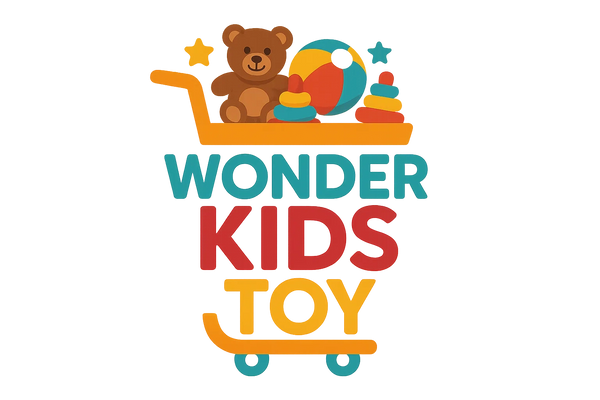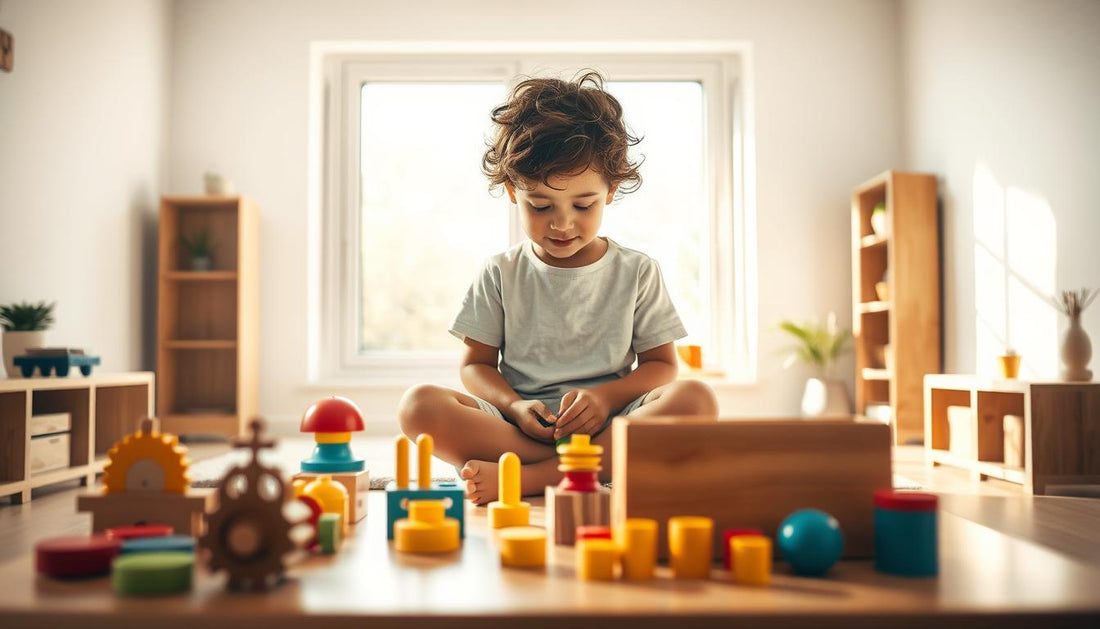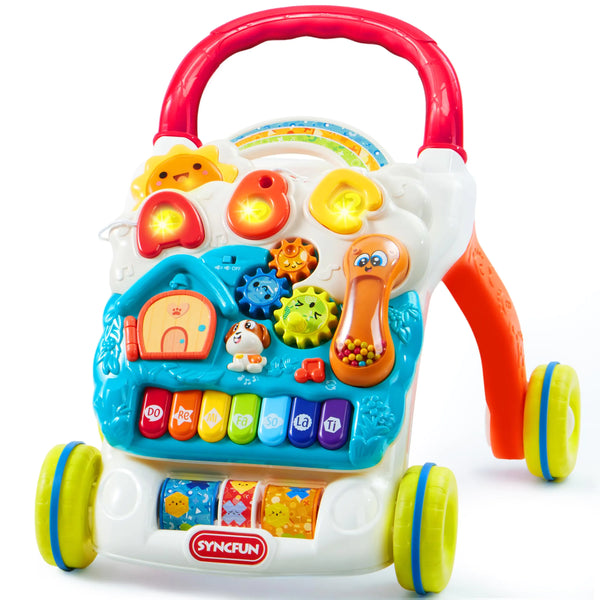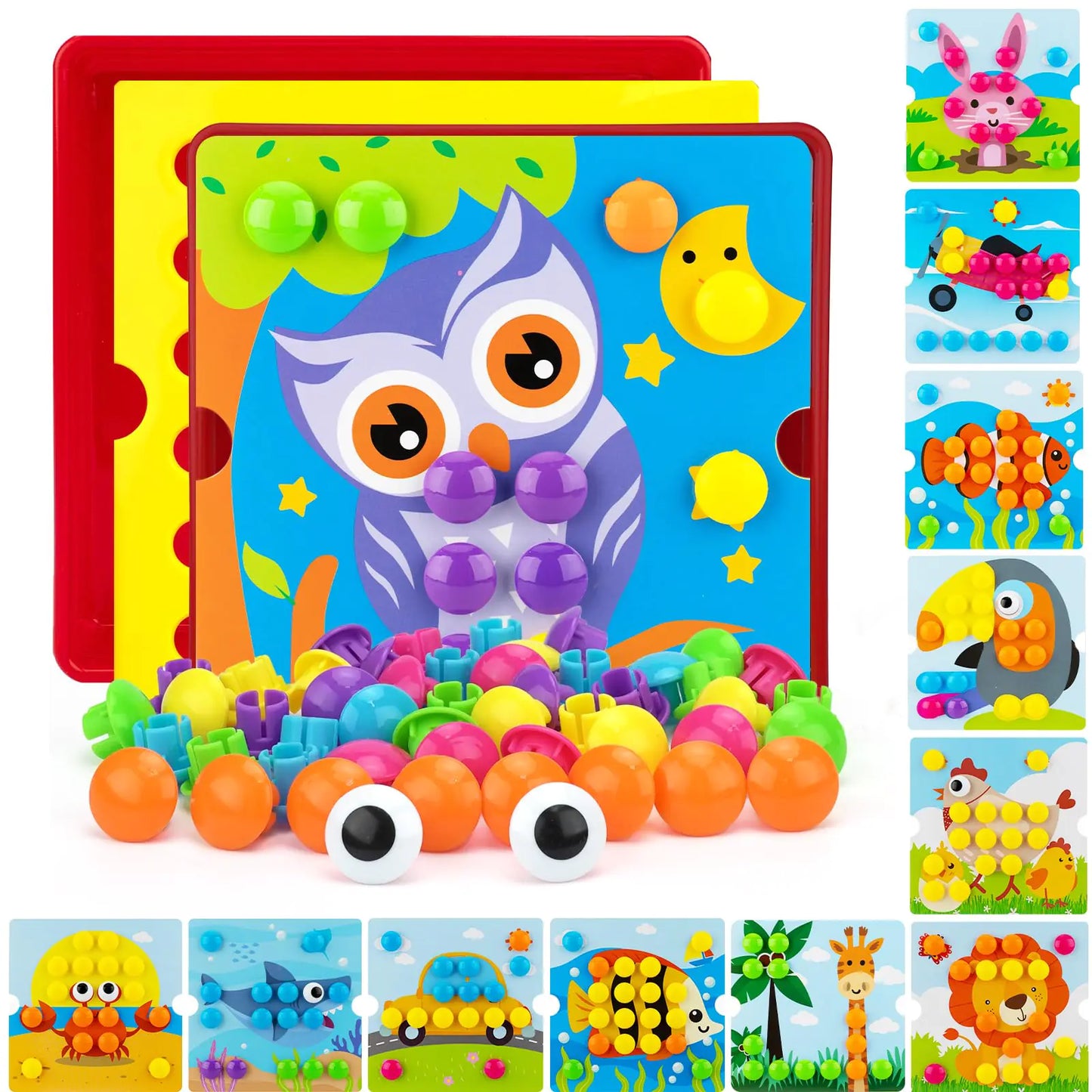As a parent, I've learned that teaching my toddler to clean up is key. The Montessori method shows how vital a tidy space is. It helps kids grow independent and learn on their own.
Maria Montessori said, "Young children focus better and feel more at peace in clean spaces." I've used Montessori Toys and simple strategies. This way, my toddler has learned to clean up and feels responsible.
Key Takeaways
- Encourage toddlers to clean up after playtime to foster independence.
- Use Montessori Toys that promote learning through play.
- Create a clean and organized environment for self-directed learning.
- Develop good habits and a sense of responsibility in toddlers.
- Implement simple strategies to make cleaning up a fun experience.
The Montessori Approach to Clean-Up
Parents can make clean-up fun and educational for toddlers by using Montessori methods. This approach believes kids are naturally curious and want to learn. By setting up a prepared environment and using Montessori materials and educational toys, parents can help kids develop good habits and a love for learning.
Understanding Montessori Principles
The Montessori way of clean-up shows that kids can take care of their space. It focuses on independence, learning by doing, and hands-on activities. By knowing these principles, parents can create a supportive space that encourages kids to learn on their own.
Some key Montessori principles include:
- Encouraging independence in daily activities
- Using specially designed materials that promote learning
- Fostering a sense of responsibility and care for the environment
Why Clean-Up is Important
Clean-up is a significant aspect of Montessori, teaching children important life skills and responsibility. Through clean-up activities, kids learn to organize, sort, and take care of things. This also improves their fine motor skills and hand-eye coordination.
Also, clean-up teaches kids about cause and effect and the value of a clean space. By making clean-up a daily routine, parents help their kids develop habits that will last a lifetime.
Setting Up a Playful Environment

My first step in teaching my toddler to clean up is setting up a play space. A tidy play area encourages meaningful play and makes clean-up easier.
Creating a Dedicated Play Space
To make a play space inviting, I focus on accessibility. This means:
- Choosing a distraction-free area for play
- Using furniture that fits my toddler's size
- Making sure the space is well-lit and comfy
This setup encourages my toddler to play and learn. It helps them understand the importance of cleaning up.
Organizing Montessori Toys Effectively
Keeping Montessori toys organized is key to a clutter-free space. I do this by:
- Using open shelves for easy access
- Grouping similar toys to make them easy to find
- Labeling bins with pictures or words
Montessori principles, like neat shelves and space between toys, enhance play quality. Organizing toys helps my toddler play independently and learn to put things back.
Open-ended toys and wooden toys boost creativity and simplify clean-up. Wooden blocks, for example, are educational and easy to store. They teach my toddler about organization.
"The way we organize our environment influences our behavior and our children's behavior."
This quote is accurate for me. A well-organized play space has helped my toddler understand the importance of clean-up.
Making Clean-Up Fun

One of the best ways to get my toddler to clean up is to make it fun. By adding play and engagement, clean-up becomes a fun activity, not a chore.
Transforming Clean-Up into a Game
Turning clean-up into a game is a great idea. I set a timer and challenge my toddler to pick up as many toys as they can before it goes off. This makes the task fun and teaches them about time and efficiency.
Another way is to have a "clean-up challenge" where my toddler and I compete. We see who can pick up the most toys. This friendly competition makes clean-up enjoyable and encourages my child to help.
Using Music to Encourage Participation
Music makes tasks feel less scary and more fun. I play upbeat, kid-friendly songs during clean-up. My toddler loves dancing while picking up toys. This makes the task more pleasant and creates a positive feeling about it.
Using sensory and eco-friendly toys also makes clean-up better. Toys made from natural materials like wood or cotton are good for the planet. They also give my toddler a fun tactile experience.
| Clean-Up Strategies | Benefits |
|---|---|
| Turning clean-up into a game | Makes the task more engaging, teaches time management |
| Using music during clean-up | Makes the experience more enjoyable, creates a positive association |
| Incorporating sensory and eco-friendly toys | Provides a tactile experience, promotes sustainability |
Establishing a Clean-Up Routine

Creating a clean-up routine is key for toddlers to learn good habits. By incorporating clean-up into our daily routine, it becomes easier and more natural.
One source says, "The more we incorporate it into our day, the less of an issue it becomes." I've found this true, as a regular clean-up routine has dramatically improved my toddler's cooperation.
Consistent Timing for Clean-Up
Setting a regular time for clean-up helps my toddler know what to do. For instance, cleaning up before snack or before a new activity is apparent. This consistency builds a sense of responsibility.
Visual Schedules for My Toddler
Visual schedules have been a big help for us. A visual routine, including clean-up, helps my toddler understand and look forward to what's next. This visual aid helps them follow the routine on their own.
Using Montessori-inspired toys in playtime also helps with clean-up. These toys are simple to store, teaching my toddler about learning through play and keeping things tidy.
Teaching Responsibility with Toys

Teaching responsibility with toys is more than just cleaning up. It's about teaching my child to own and care for things. This helps them learn essential life skills that will help them grow.
Encouraging Independent Play
The Montessori method encourages children to play independently. By letting my child pick their games with educational toys, I help them feel independent. This independence allows them to learn to take care of their things without being told.
Watching my child play alone, I see them focus better. This is because Montessori materials help them learn and explore by themselves. It lets them feel in control of their world.
The Role of Ownership in Clean-Up
When my child owns their toys, they're more likely to clean up. I help them feel this way by letting them pick their toys. This makes them proud of their things and feel connected to them.
Studies show kids clean up better when they own their toys. By teaching my child to own their toys, I help them see cleaning up as a positive thing. This builds good habits that will last forever.
The Impact of Parent Involvement

Being involved in my toddler's playtime and clean-up has a big impact. It teaches them the value of cleaning up and strengthens our bond.
Leading by Example
Children often copy what adults do. So, I clean up with my toddler to show it's a team effort. Using wooden toys and open-ended toys makes clean-up fun and creative.
Showing my toddler that everyone helps with cleaning up is key. This has made them more willing to put away their toys after play.
Engaging in Clean-Up Together
Doing clean-up together with my toddler is effective. We make it a game by seeing who can pick up the most toys or sing a clean-up song. This turns cleaning up into a fun activity.
| Clean-Up Strategies | Benefits |
|---|---|
| Leading by Example | Demonstrates shared responsibility |
| Engaging Together | Makes clean-up enjoyable |
| Using Wooden/Open-Ended Toys | Encourages creativity |
Using these strategies has dramatically improved my toddler's clean-up habits. It's a journey that needs patience, consistency, and positive encouragement.
Choosing the Right Montessori Toys

Choosing the right Montessori toys is key to easy clean-up and a love for learning. The Montessori method focuses on materials that help kids become independent and responsible.
Selecting Toys That Are Easy to Store
When picking Montessori toys, think about how easy they are to store. Toys that are simple to store help my toddler clean up after play. I look for toys that are small and can fit on shelves or in bins.
For example, sensory toys like wooden blocks, stacking cups, or fabric baskets are fun and easy to store. They teach my child about learning and keeping things tidy.
Benefits of Open-Ended Toys for Learning
Open-ended toys are a big part of Montessori. They spark creativity, imagination, and problem-solving. Unlike toys with one use, open-ended toys keep kids engaged for longer.
Montessori-inspired toys like wooden puzzles, shape sorters, or building materials are great. They challenge my child's mind while also helping with fine motor skills and hand-eye coordination.
- Promote creativity and imagination.
- Encourage problem-solving skills
- Foster more extended engagement and deeper learning
By picking the right Montessori toys, I create a space for my child to learn and grow. It's all about finding toys that are fun and practical for storage and clean-up.
Positive Reinforcement Strategies

Teaching my toddler to clean up after play has been a challenge. But using positive reinforcement has been key. It helps my child learn good habits and feel responsible.
Celebrating Small Achievements
Celebrating small wins motivates my toddler to help with clean-up. A simple "Great job!" or hug can make a big difference. It boosts their confidence and makes cleaning up fun.
Using eco-friendly toys also helps with clean-up. These toys teach my child about sustainability. They make cleaning up a fun part of playtime.
Using Praise to Motivate My Toddler
Praise is a great way to motivate toddlers. By praising their actions, like "You did a great job putting away your blocks," I encourage them. This method motivates my child and shows them the value of their actions.
Learning through play is key in our daily routine. Making clean-up part of play makes my toddler more willing to help. This approach fits with learning through play, where cleaning up is a valuable learning experience.
| Strategy | Effectiveness | Tips for Implementation |
|---|---|---|
| Celebrating Small Achievements | High | Use verbal praise and physical gestures like hugs. |
| Using Praise to Motivate | Very High | Be specific with your praise, focusing on the action. |
| Incorporating Eco-Friendly Toys | Moderate | Choose toys made from sustainable materials. |
These positive reinforcement strategies have helped. My toddler is now more willing to clean up after play. It's a journey that needs patience, consistency, and positive reinforcement. But the results are worth it.
Challenges I Encountered

Teaching my toddler to clean up after playtime was tough. It tested my patience and my grasp of the Montessori method. One big challenge was my child's unwillingness to clean up.
Resistance to Clean-Up
My toddler didn't want to put away Montessori Toys and other educational items. They liked to keep playing. I learned that staying calm and patient was key, as many Montessori experts say.
Making clean-up fun helped a lot. For example, using a timer to see how many toys they could clean up fast made it exciting.
Overcoming Messy Play Situations
Messy play was another big challenge. With educational toys like blocks and puzzles, our play area often got messy. So, we cleaned up a bit at a time, even while playing.
This kept our play area tidy and taught my toddler about keeping their space clean. By involving them in the clean-up, we overcame the mess and resistance.
With patience, consistency, and positive feedback, my toddler learned to clean up. This journey has made them more responsible and strengthened our bond as we keep our home tidy together.
Adapting to My Toddler's Development

As my toddler grows, I've learned the key to a good clean-up routine is to adapt. It's about understanding their changing needs and abilities. Then, we adjust our clean-up approach to fit their growth.
Using Montessori materials and wooden toys has been very helpful. These items are not just durable. They also help my toddler feel responsible and care for their space.
Recognizing Growth in Clean-Up Skills
Seeing my toddler's clean-up skills grow is a big deal. They've moved from simply putting away toys to recognizing the importance of a clean space. This allows me to raise my expectations and assign them more complex tasks.
This growth isn't just about cleaning. It's also about feeling like they own the space. By celebrating their wins, I keep them motivated to improve their cleaning skills.
Adjusting Expectations Over Time
Changing my expectations for my toddler has made clean-up both fun and effective. As they get more confident, I give them bigger tasks. This makes them feel proud and helps them grow.
This approach also boosts their fine motor skills and hand-eye coordination. Being flexible and adapting to their needs makes clean-up a fun challenge for them.
Introducing Visual and Sensory Cues

Adding visual and sensory elements to clean-up makes it more fun for my toddler. This approach turns a chore into a fun activity.
Using labels and icons is a great way to get my child to clean up. I put pictures or icons on storage bins to show what's inside. This helps my child learn and improves their skills.
Using Labels and Icons
Labels and icons make clean-up easier and more fun. I label each bin with a picture or word. This makes it clear what goes where.
Incorporating Texture in Toy Storage
Texture in toy storage also makes clean-up better. I use bins with different textures, like wooden crates or fabric baskets. This adds a fun touch to the task.
By mixing visual and sensory cues, clean-up becomes more fun for my child. This method encourages my toddler to help out. It also boosts their creativity and imagination with open-ended toys and sensory toys.
Encouragement through Peer Interaction

Learning from others is a great way to pick up good habits, like cleaning up. As a parent, I've seen that my child is more likely to help with clean-up when they're with friends.
Learning from Other Children
When kids play together, they learn from each other. This interaction helps them develop good habits, such as cleaning up. Using Montessori-inspired toys that are easy to store is very helpful.
For example, during playdates, my child is more likely to put away toys when they see their friends doing it. This makes clean-up a fun team effort, not just a chore.
Playdates and Group Clean-Up Activities
Setting up playdates and group activities helps my child clean up. Kids tend to follow each other's lead, including cleaning up after play.
| Benefits of Group Clean-Up | Examples | Outcomes |
|---|---|---|
| Promotes teamwork | Playdates with friends | Develops social skills |
| Encourages responsibility | Group clean-up activities | Fosters a sense of duty |
| Makes clean-up fun | Using eco-friendly toys | Enhances the play experience |
By using eco-friendly toys in our playdates, we teach our kids about cleaning up and caring for the environment. This approach makes play and clean-up a fun, learning experience for my child.
Reflecting on the Journey
Looking back, teaching my toddler to clean up has been a considerable learning experience for us. We've used the Montessori method and Montessori Toys. This has helped create a space where they can learn and grow on their own.
Assessing Progress
It's essential to see how well our clean-up routine is working. I've noticed my child taking more responsibility for their toys and play area. This shows they're learning and growing.
Adapting for the Future
Keeping our clean-up routine effective means always looking for ways to improve. As my child grows, we'll need to adjust our approach. This will help them continue to learn essential skills through play.
Using the Montessori method and Montessori Toys has been a great choice. It's helped my child develop good habits and a sense of responsibility. This has made their learning through play even more rewarding.
FAQ
What is the Montessori approach to clean-up, and how can it benefit my toddler?
The Montessori method focuses on a clean, organized space. It helps toddlers learn to clean up on their own. Using Montessori toys, like wooden ones, helps kids develop good habits and feel responsible.
How can I make clean-up fun for my toddler?
Turn clean-up into a game or use music to get them involved. Add sensory toys and eco-friendly items. Visual cues and textures in storage make it more fun.
What type of toys are best for encouraging clean-up in toddlers?
Choose Montessori toys, like wooden and open-ended ones. They're easy to store and encourage kids to play independently. This helps them learn to clean up and feel responsible.
How can I establish a clean-up routine that my toddler will follow?
Set a regular time for clean-up and use visual schedules. Make it part of daily life. Clean up together to show them it's essential.
What are some strategies for overcoming resistance to clean-up in toddlers?
Understand why they might resist. Make clean-up fun by using positive words and adjusting to their growth. This helps them get into the habit.
How can I encourage my toddler to take ownership of clean-up?
Encourage them to play alone and feel like they own the space. Use Montessori toys to help them feel responsible for cleaning up.
What role does parent involvement play in encouraging toddlers to clean up?
Parents play a key role in teaching toddlers to clean up. Show them how it's done, clean up together, and praise their efforts. This helps them develop good habits.
How can I adapt to my toddler's development and adjust my expectations for clean-up?
Notice how they're getting better at cleaning up, and adjust your expectations. Use Montessori materials to encourage creativity and learning through play.















